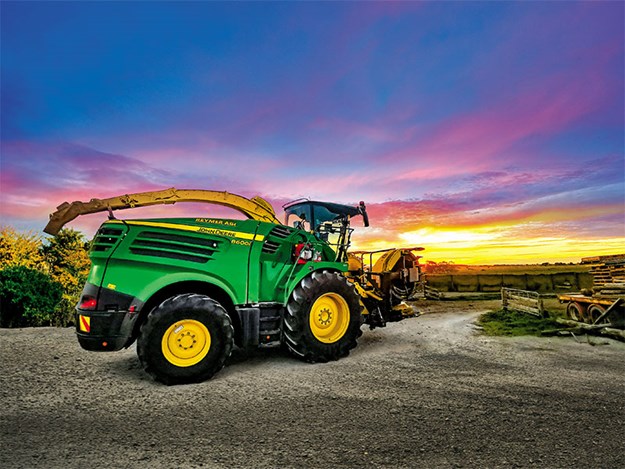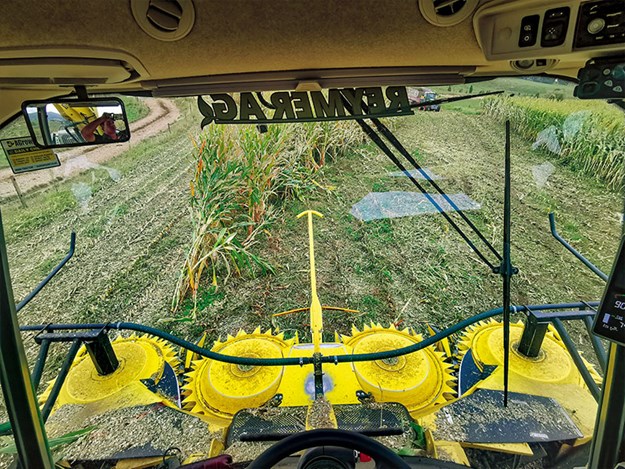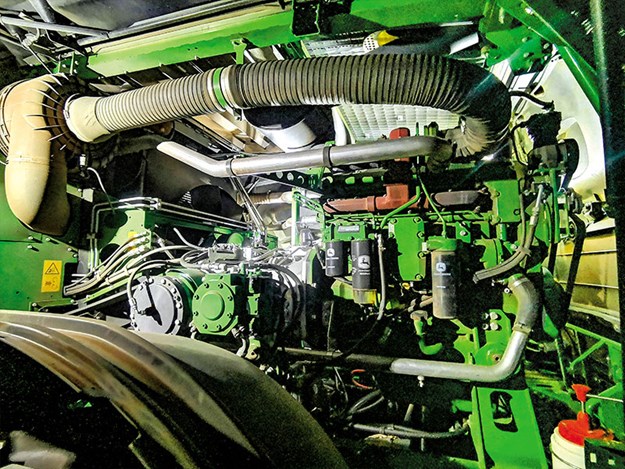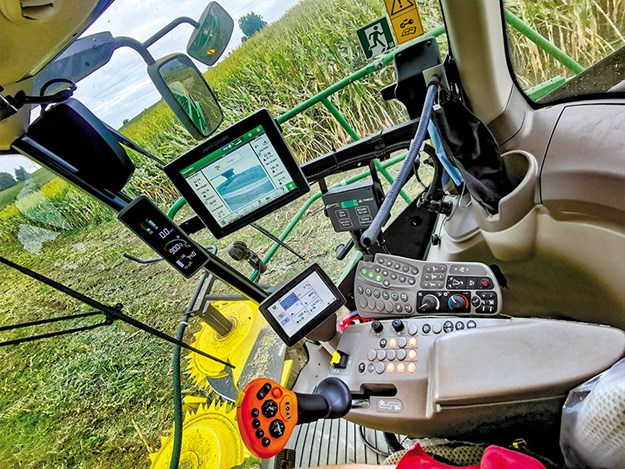Review: John Deere 8600i self-propelled forage harvester
The forage harvester plays a crucial role in terms of maximising quality and efficiency come harvest time. Farm Trader test drives the John Deere 8600i self-propelled forage harvester.
Add a shortage of skilled drivers to the mix and it all adds up to increasing pressure on contractors to get through all their clients in the short windows available.
While there are multiple machines available to get the job done, one of the fastest and most efficient machines out there is the self-propelled forage harvester (SPFH).
Self-propelled forage harvesters not only get the job done fast with a lot of throughput but silage quality out of the chute is also up there with most, having a variable length of cut and inoculant applicators.
With most new SPFHs costing up around the million-dollar mark, contractors definitely need this investment to work for them to help keep clients happy with minimal downtime, while putting high-quality silage in the pit to make it count when it comes to feeding out.
With this in mind, Waikato contractors Reymer Ag opted for a new John Deere 8600i forage harvester when looking at a new machine, with chop quality and throughput key priorities. With five decades experience of building self-propelled harvesters, John Deere brings plenty to the table in terms of technology and innovation.
Specs
 |
|
John Deere 8600i self-propelled forage harvester
|
With increasing regulations and costs coming into the industry, getting the most out of the crops is of vital importance. From cultivation and planting to harvesting and stacking, quality of the job is a must.
The 8600i is the highest horsepower produced by John Deere with the narrow drum configuration measuring a 660mm wide harvest channel. In turn, this gives a high throughput while ensuring chop quality is nothing short of perfect. The cutting drum has 48 knives for maize being fed by two fully variable, compressing feed rollers, feeding the drum a constant mat of maize.
Powering the mighty machine is a 13.5-litre, Tier 2 John Deere diesel engine putting out an impressive 460kW (617hp). Tier 2 means no AdBlue (most users will appreciate that), meaning one less thing to fill up, along with none of the extra issues it seems to cause on most machines.
This engine is well suited to the size of the harvester and can hold on well as the rpm starts dropping. While this harvester could easily handle a 10-row head, the team at Reymer Ag are running an eight-row 460-plus maize head to keep weight down on the front axle on local peat soil and to contour on the hills better than a larger machine.
Speaking of contouring, it’s extremely good on this machine. Having three height sensors on the head, the harvester automatically tilts the head to keep an even stubble level, leaving a pristine paddock.
This system only works while under five kilometres per hour; go much quicker and it doesn’t react fast enough. Luckily, manual override is just a push of the number 3 button, which puts it into an oil pressure setting.
Additional row sensors are on the centre point for row guidance. These are amazingly handy to keep with the rows, keeping the machine at max capacity and allowing the operator to focus more on the chute and filling the trailer.
Being hydraulically driven, the operator can set the header speed for optimal pickup and feeding of the crop. This is also gentle on clutches and all components on start-up, as it ramps up to rpm slowly instead of firing it into gear.
To keep the machine running, there’s a 1100-litre diesel tank sitting in the low mid-section of the body. Being able to refuel from ground level saves dragging a hose up steps and eliminates the possibility of spilling diesel down the side. A freshwater tank is also down low by the steps. This is helpful whether you’re washing your hands after servicing or if some inoculant needs mixing.
The John Deere 8600i is spec’d with the full led light package. There’s not a lot that goes unseen from the cab in the dark with 360-degree lights strategically placed to give optimum view with minimal glare. What I did find strange for a 2021 model was that the taillights are still halogen bulbs under a big lens. Nevertheless, it still looks pretty nice at night when following it on the road.
After coming from the maxed out 7000 series harvester, one of the first noticeable differences (apart from the sleek styling) is how much more balanced this 8600i machine is. Moving the engine over the rear axle eliminates the need for many extra weights to be added to the rear. The ones that are there are stacked vertically in a tidy fashion, unseen to the eye. This is a big plus when harvesting peat ground when excess weight can soon cause a machine of this size to be mistaken for a submarine. It also aids in road transport, keeping it smooth and stable with minimal bouncing (plus, there’s the fact that no one enjoys adding and removing weights on the best of days).
Keeping things rolling
 |
|
With few places for material to build up, a quick wash is easily achievable
|
The 800/70R42 tyres not only look great but they also help in performance. Being some of the highest rolling diameter tyres available on this machine, they allow a greater portion of the tyre in contact with the soil. This lighter footprint minimises ground compaction and gives a bit more ground clearance. Sitting well above most maize crops, it would be a rare occasion to get a crop that stands above this machine. Is that a challenge? Someone surely has to give it a good shot.
Smart thinker
 |
|
A clear unobstructed view over the head
|
Having the Harvest Lab 3000 is a real advantage when it comes to analysing the crop. An NIR sensor unit placed on the first section of the chute gives the operator a real-time view of what’s going through the machine. Ultimately leading to harvest reports and yield mapping, from this information, it’s possible to research why certain areas of the paddocks are or are not performing as they should. This is also helpful as the farmer can see exactly how many tonnes they’ve received, allowing them to plan feed amounts for the coming months. The Harvest Lab is extremely easy to remove for cleaning or to mount the blanking plate in.
With a range of kernel processor (KP) options available, the John Deere XStream KP was selected for this machine (featuring temperature monitored bearings and aiding in a more rapid fermentation of crops).
An optional crane with an electric hoist was also a part of the package, making it easier to install and remove the KP for storage or maintenance. This KP has done a beautiful job ensuring all kernels are cracked. When you can pick up a handful of maize and see nothing that resembles a kernel – it’s a lovely sight.
Live telematics through the John Deere operations centre APP allows managers and operators to monitor the machine from the office. Being able to see the machine’s location, yield, moisture, fuel usage data and an array of other information is extremely handy in job planning while saving a few phone calls throughout the day. Not to mention when stacking seeing how far through the block the harvester is.
Service and maintenance
 |
|
LED lights in the engine bay, which has plenty of space as this in a non-AdBlue model
|
This particular machine has been spec’d with Dura Line on all the wear parts (with an impressive three-year/3000-hour wear guarantee), which significantly reduces the cost of ownership and reduces the maintenance needed before each season.
Speaking of wear parts, the chute has a modular design where the wear liner is a structural part of the chute. A worn-out liner found too late will not damage the chute structure and replacement will bring the chute to an ‘as new’ state.
Dropping the head is straightforward. It’s no big deal to drop the header off for closer inspection into the cutterhead. One lever unlocks the head ready for removal after the stands have been dropped. A dog gear coming out of the cutter head lines up with the header, providing all the drive without any human intervention into coupling and uncoupling a drive shaft. If you want to delve deeper into the cutterhead, a simple locking mechanism releases the top, and along with a bolt at the bottom, the whole feed roller assembly swings open for knife and shear bar viewing or maintenance.
A simple but effective bubble level gauge sits on top of the housing to help ensure the housing is level. Without this, you run the risk of the unit swinging in or out rapidly.
Another option for knife viewing is with the header attached (only certain types – not maize heads). A similar locking system releases the top and pivots to a 35-degree angle allowing a great view of the components. In my experience, if it’s difficult to do things like this, they aren’t going to get done as often as they should. With this set-up being this easy, you wouldn’t hesitate in dropping the head or even opening the cutterhead unit for inspection or cleaning when required. And with automatic header recognition, programming the harvester’s computer to the header is a thing of the past. Hook it up and it’s all pre-loaded for you.
The daily task of checking the engine oil can be a task on its own with the dipstick sitting pretty high in the engine bay. The ladder supplied in the machine is required or the less OSH approved method of climbing up and over the tyre is used to get up in there to check it. Luckily, there are light strips under all the opening panels providing a wicked view of all the obstacles in your way. These lights are brilliant at night for servicing or a general clean.
Checking the radiator screens and KP is a lot easier with built-in steps leading up the side with their own specialised door. It’s a nice touch, as it makes the door lighter as the bigger engine bay one is able to stay shut. Having the John Deere XStream KP fitted, a sight gauge is required to be checked daily as it sprays oil directly into the bearings. It’s something I’m not used to seeing, as it does have some sort of airborne mist coming out of the unit beside the cab. You can tell a fair amount of thought and testing has been put into these machines as build-up of crop and dirt is minimal and where it does build up, it’s easy to clean. Plus, John Deere supplied a laminated checklist of places build-up of foreign objects are likely to accumulate.
Operating and cab
 |
|
Excellent visibility of the chute and trailer from in cab
|
As anyone who’s sat behind the wheel of a John Deere will know, these machines have a distinct feel to them – and that hasn’t gone astray in this harvester either. From the moment you sit down, you feel the company’s history. Some may call it a touch outdated with their interior colour choice, buttons, and controls, but that’s what John Deere fans know and love.
One of the first things you notice sitting down in the cab is how much visibility there is over the head and out the side towards the trailer. John Deere has kept the view uninterrupted by angling all the pillars and putting a slim dash on the A corner pillar. It provides all the necessary information on engine, ground and drum speed clearly at a fast glance.
As you’ll see, the side doors are raised at the rear for optimum viewing of the chute allowing every inch of the trailer to be filled well.
Coming across to the armrest, first looks are that it looks great, but most buttons being the same colour and style, it’s hard to distinguish between them without looking. With time in the seat, you soon get to know where the one you want is without too much hassle. I did notice that if you go to use the radio controls on the armrest, you smack your elbow on the back of the cab, which certainly gives you a wake-up. The cup holder to the right of the seat is handy to keep an open drink held well. However, I’d like to see some other kind of slot or storage box to chuck your phone or whatever else into.
With the joystick being the familiar style as previous models, with a few extra programmable buttons on the back, it still doesn’t fit the hand as well as it should at first and can feel awkward to hold, but after a few hours, it seems to come into place.
Even though reversing is not the way you’d want to be headed, it’s hard to avoid in some situations. I find pulling back on the stick into reverse is an unnatural angle of the wrist and you soon feel it. The good guys at AgrowQuip Cambridge hooked the CB radio up to the centre button on the back of the joystick and wow, it saves a heck of a lot of hassle as your third arm doesn’t need to reach for the microphone anymore. A simple press of the button, then opening your mouth and boom – the trailer drivers know what the ‘go’ is.
Filling the trailer is made easy thanks to the camera on the chute. It’s definitely needed, as the rear of this machine is rather high.
When put in reverse, a camera mounted at the rear shows up on the little screen. While it would be handy for hitching up to trailers, over here that’s a rarity and would be handier if it had a wider angle showing the outside edges of the machine. The mirrors on the right side are nice, with a wide-angle pointing down past the tyre to the ground. This is helpful when trying to get through tight gateways. It would, however, be a nice touch to have one on the left also for when it gets to ‘suck in and hope’ tight, especially when it comes to those pesky gate gudgeons and 11-foot gates.
Having a sequence button on the armrest saves time countlessly during the day. Pushing one button, the head unfolds, beacon lights turn off, and the chute goes up ready for back shooting. You chop the paddock then at the end; the same button does it in reverse. John Deere has also integrated more shortcuts into the joystick with double taps of certain buttons. Changing the chute position from one side to the other and lots of other helpful features. Having the chute height on a switch on the back of the joystick makes it so much smoother to raise or lower the chute while in motion.
Onto a more important part of the cab: the fridge – arguably the best part of the whole machine (although generally, this depends on whether its owner or the operator you’re talking to). Located under the passenger seat, it’s a decent, large size, with either front or top opening to hold your breakfast, lunch, and dinner for those long days and nights.
One final point that’s a bit of a disappointment is the 4WD button on the floor. When operating on hillsides, as you go to reverse, the rear wheels start to slip and send the harvester into a bounce. However, this is easily overcome by simply disengaging the 4WD as you reverse, then re-engage when you go forward.
The button’s new location is difficult to find and requires you to take your hand off the joystick to press the button while your foot sits there and enjoys the ride. There are footpegs to extend and rest your legs, making the day a lot more comfortable. My last niggle in the cab comes from the steering wheel. This might be getting fussy but on some Deere models, they are rock hard. I’d love to see a softer steering wheel as standard, as it doesn’t take long to get a sore hand.
Summary
 |
|
Layout is optimised for operator convenience and customisable for individual preferences
|
Getting quality forage comes from a quality machine. John Deere has clearly showcased its knowledge and experience in forage harvesters to put a great package together here. Being such a vital piece of machinery, it needs to be reliable, consistent, and have minimal running costs, and John Deere has somehow wrapped all that up under sleek styling.
Find new and used farm machinery for sale in NZ
Keep up to date in the industry by signing up to Farm Trader's free newsletter or liking us on Facebook




.jpg)





.jpg)
.jpg)
.jpg)
.jpg)
.jpg)

